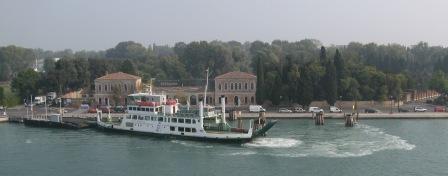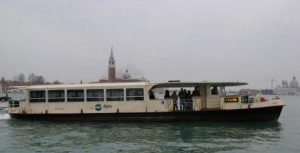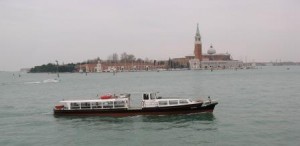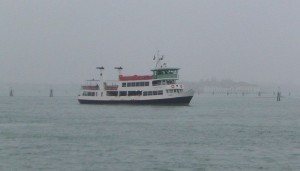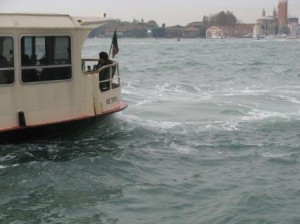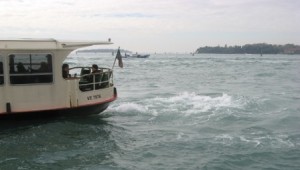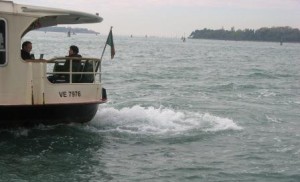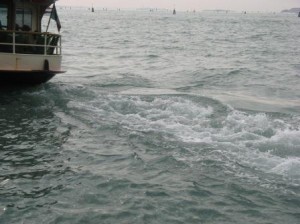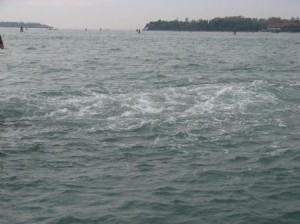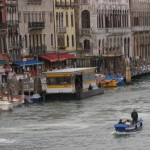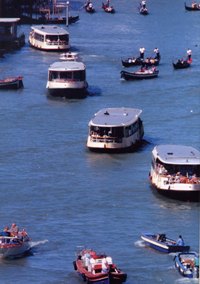If there’s one thing people everywhere know about Venice, it’s that sometimes those romantic canals try to barge into your house.
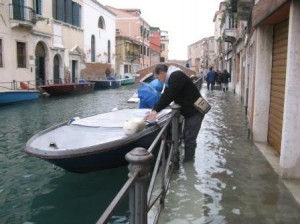
Rather than “flooding,” Venetians call this acqua alta, or “high water” (literally “high tide”). Or, depending on how deep it’s likely to be, sometimes they call it “acqua in terra,” or “water on the ground,” which is less dramatic and often more accurate.
I’ve got water on the brain at the moment because night before last, the warning siren sounded again. It indicated the lowest predicted level, one out of four, which was nice, and in the end we barely got any at all. With rare exceptions, acqua alta, more than being some kind of apocalyptic affliction, as it is often portrayed, is really a low-grade nuisance. If it happens often, as it has this winter, it becomes as annoying as any other uninvited guest who doesn’t realize it’s time to go home.
There are so many notions people have about high water, based on the generally inaccurate and overwrought accounts in the press, that I thought I’d review and readjust a few of them.
- It’s always happening, or likely to happen. Not really. This winter we’ve had more acqua in terra (again, not really what I’d call “alta”) more often than many other winters. On the other hand, there have been years when I haven’t put my boots on even once. Yet all kinds of claims keep being thrown around in stories written about this little phenomenon. The website of the basilica of San Marco states that water begins to flood the Piazza San Marco, just in front of the church, 250 days a year. Check my math, but that works out to 8 months. A photo caption on the National Geographic website claims that Venice has high water ten times a month. That’s crazy talk.
- It creates, or will create, really big, really bad problems.
If for some reason your kids (or somebody else's) don't have boots, high water can be somewhat demanding. Then again, why don't they just go barefoot? I've done it and I'm still alive. I’m not sure what people think those might be, but the words “acqua alta” seem to inspire a lot of hyperventilating outside Venice (and even inside Venice, mostly from merchants around the Piazza San Marco). I’m not saying that having to put the stuff in your store up on higher shelves isn’t annoying, or that having to sweep out the receding brackish water and then wash the floor with fresh water isn’t annoying. But in 9 cases out of 10, the situation doesn’t exceed the annoyance level — not much worse than having to shovel the snow out of the driveway for the fiftieth time this winter.
- It’s going to be alarmingly deep. Those fun photos of people rowing boats in the Piazza San Marco don’t ever show how deep the water actually is. (In fact, those boats can be rowed in four inches of water.) Venice isn’t flat as a griddle — the streets undulate as much as the water does, which you discover when the water comes ashore. There can be dry spots even in a wet street.
- The entire city’s drowning. The municipal tide center reports that when the tide is predicted to reach 110 cm above mean sea level, 14 percent of Venice has water on the ground. And that that might not be a depth of more than an inch or two. Fourteen percent doesn’t strike me as an immense area, and several percentages of that would always be the Piazza San Marco, the lowest point in the city.
When the water starts to rise in the Piazza San Marco, it looks like this. Sometimes it doesn't get any higher than this amount. I guess you could say Venice was flooding, but there are still plenty of dry spots left. - It’s going to hurt you, or hurt something. Not that I’ve noticed. Acqua alta is nothing like real floods. Rivers overflowing their banks in torrential rainstorms are dangerous; tsunamis are dangerous. With acqua alta, nobody dies. People survive, buildings survive, art works are fine. The water rises very gently, even politely. Despite the distraught tones in which the event is almost always reported, I still don’t understand why the mere term seems to have acquired such a menacing overtone.
If the water rises near a low sidewalk, it flows over the edge. It's even more common -- as here in the Piazza San Marco -- for it to come up through the storm drains. Naturally it also goes out the same way.
Acqua alta is not dangerous. It’s not even especially upsetting. In my experience, if it happens more than a few times, though, it can begin to seem like a two-year-old who’s gotten into the “Why?” groove. Nothing wrong with it, really, except that it gets to be irritating. The kid turns three, and spring and summer come, and all of this fades from memory.
In my next post: A few real-life aspects of acqua alta which tend to mitigate its fearsome reputation.
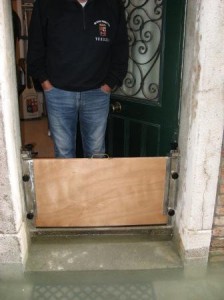
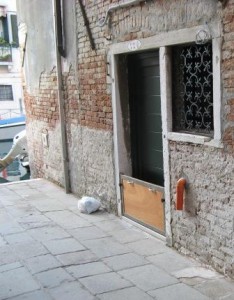

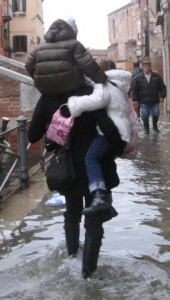
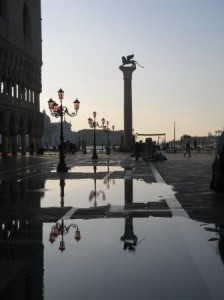
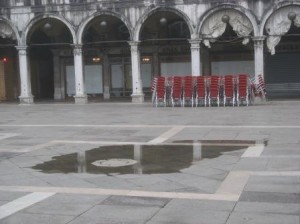


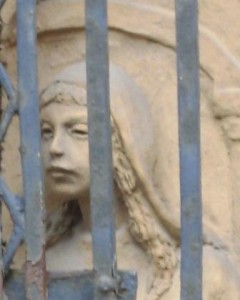
 Lest you think that this effusion represents the apex of Victorian nostalgia — the anonymous donor clearly beat Mussolini to the public declaration of worship of their Latin forebears — let me note that a statue of Cerere also stands atop the Chicago Board of Trade, as well as appearing on the Great Seal of the State of New Jersey, holding a cornucopia. These notions die hard. Or not at all.
Lest you think that this effusion represents the apex of Victorian nostalgia — the anonymous donor clearly beat Mussolini to the public declaration of worship of their Latin forebears — let me note that a statue of Cerere also stands atop the Chicago Board of Trade, as well as appearing on the Great Seal of the State of New Jersey, holding a cornucopia. These notions die hard. Or not at all.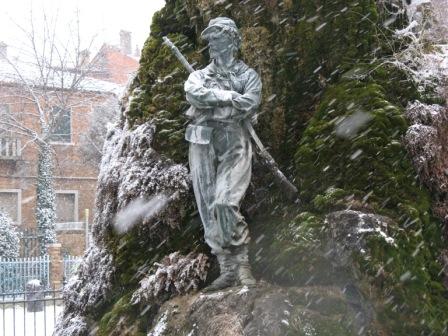
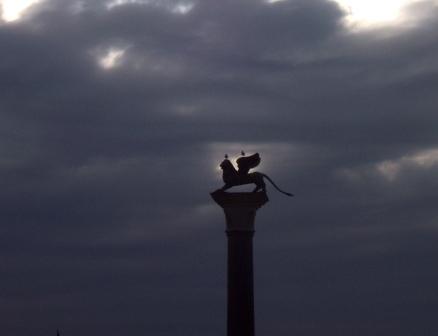 Nothing against gray. Gray can also be beautiful here, often more beautiful than blue.
Nothing against gray. Gray can also be beautiful here, often more beautiful than blue. Gray actually has a lot of points in its favor.
Gray actually has a lot of points in its favor.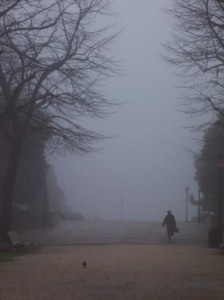 Unless you don’t like humidity, in which case gray is not your color.
Unless you don’t like humidity, in which case gray is not your color.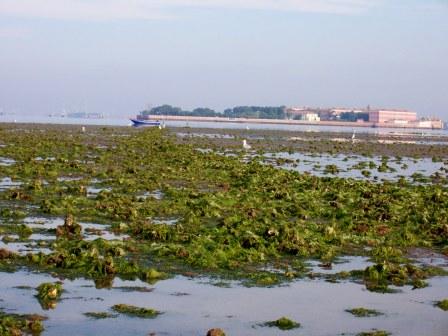 Oddly, this low tide happened at dawn in June a few years ago, rather than dusk in January. But you get the idea.
Oddly, this low tide happened at dawn in June a few years ago, rather than dusk in January. But you get the idea.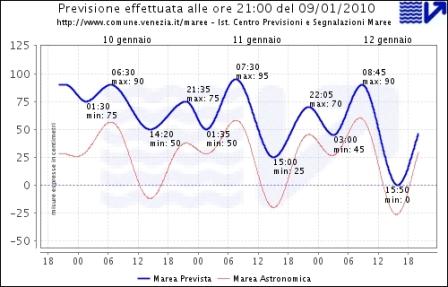 The lower line indicates the previously forecast high and low tide levels. The upper line traces what is really happening. Quite a difference. And this went on for days.
The lower line indicates the previously forecast high and low tide levels. The upper line traces what is really happening. Quite a difference. And this went on for days.